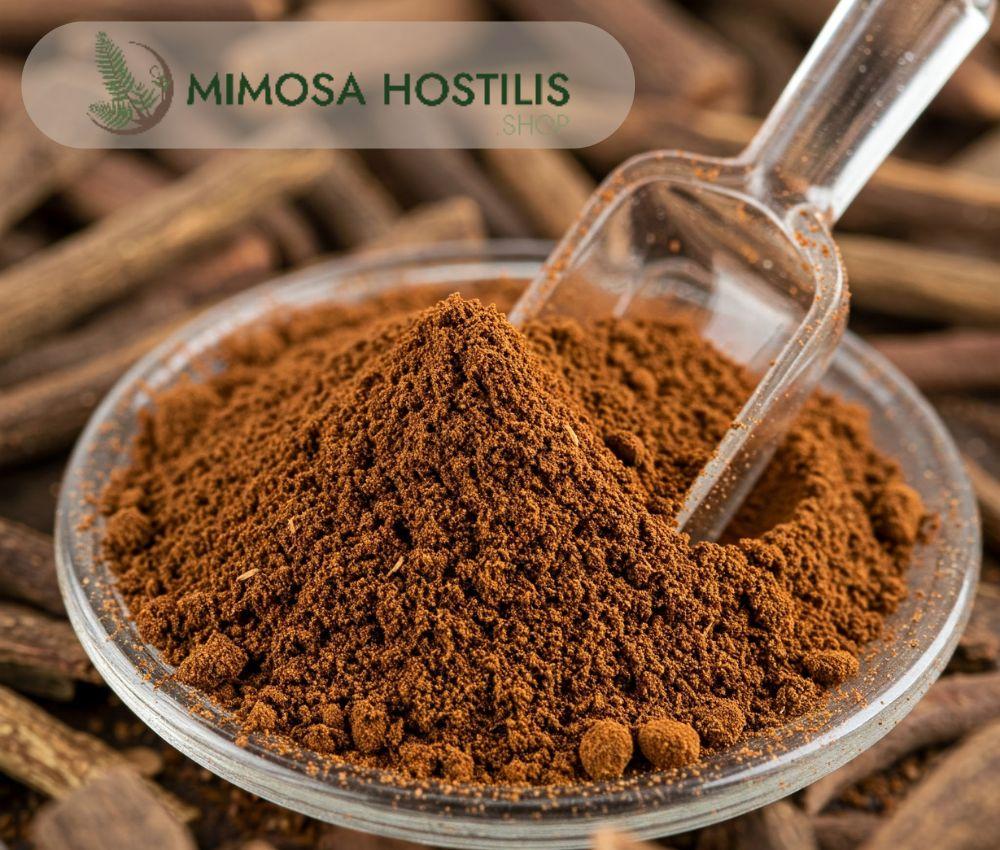Mimosa Hostilis Root Bark: Myths, Medicine, and Modern Use

Mimosa Hostilis, also known as Mimosa tenuiflora, has intrigued humans for centuries. From ancient rituals to contemporary wellness trends, the root bark of this remarkable tree has consistently held a revered place in cultural, medical, and even spiritual frameworks. Known for its vibrant inner root bark, rich in natural dyes and healing properties, this plant has sparked both fascination and misinformation.
But what’s true, and what’s just myth? How is Mimosa Hostilis root bark actually used today? Join us as we dig into the history, medicinal potential, and modern applications of this botanical marvel—including what you should know before buying or using Mimosa Hostilis inner root bark powder.
What is Mimosa Hostilis Root Bark?
Mimosa Hostilis, or Jurema in its indigenous name, is a small tree native to regions of South and Central America, particularly found in Brazil and Mexico. The tree is best known for its inner root bark, which has a long history of use in traditional medicine, spiritual ceremonies, and natural dyeing processes.
The root bark specifically houses an array of bioactive compounds that make it unique, with high concentrations of tannins, flavonoids, and alkaloids. But one stand-out chemical component, dimethyltryptamine (DMT), is largely responsible for propelling Mimosa Hostilis into modern discussions around spirituality and plant medicines.
Dispelling Common Myths About Mimosa Hostilis Root Bark
Like many plants with a long history of use, Mimosa Hostilis is surrounded by misconceptions. Let's separate myth from reality:
Myth 1: Mimosa Hostilis is Exclusively Psychedelic
While the tree is frequently associated with psychedelic substances because of its DMT content, Mimosa Hostilis root bark is not inherently psychedelic by itself. DMT must be chemically activated, typically combined with a monoamine oxidase inhibitor (MAOI), to produce psychoactive effects. For centuries, cultures primarily used the plant for purposes that had nothing to do with its psychoactive properties.
Myth 2: All Mimosa Hostilis Root Bark is the Same
Not all Mimosa Hostilis inner root bark is created equal. Its potency, quality, and effectiveness depend on how it’s sourced, harvested, and processed. For example, sustainably harvested Mimosa Hostilis grown in its native regions typically has richer pigment and higher concentrations of active compounds compared to plants cultivated outside ideal conditions.
Myth 3: Anyone Can Use Mimosa Hostilis Safely
Despite its many benefits, Mimosa Hostilis should not be approached without understanding its components. Allergic reactions and potential interactions with other medications are a possibility, emphasizing the importance of education and moderation when using the plant, particularly its inner root bark.
Traditional Medicinal and Cultural Uses
Long before Mimosa Hostilis made its way into contemporary health and wellness culture, it served ancient civilizations in a more practical way. Indigenous peoples in South America valued the tree as an essential resource for:
1. Wound Healing
The tannins in Mimosa Hostilis root bark powder possess antimicrobial and astringent properties, making it an effective wound healer in traditional medicine. It’s still widely used to treat burns and cuts by mixing the powdered bark with water to create medicinal pastes.
2. Skin Care
Even centuries ago, the bark was a popular solution for treating skin conditions like rashes, infections, and acne. The antioxidants it contains help combat inflammation and stimulate cell repair for smoother skin.
3. Ceremonial Applications
Enter the world of shamanic rituals. Indigenous groups used Mimosa Hostilis in spiritual ceremonies to connect with the spiritual realm, often in combination with other plant medicines to activate its psychoactive potential. Known as Jurema Wine, this traditional preparation holds cultural importance in Brazilian and South American indigenous communities.
4. Fabric Dyes
Beyond medicine, Mimosa Hostilis is prized for its natural coloring properties. The inner root bark is often processed to create a vibrant purple or reddish-brown dye used for textiles and art.
Modern-Day Uses of Mimosa Hostilis Root Bark
Today, the uses of Mimosa Hostilis have extended far beyond traditional contexts, appealing to new audiences across wellness, beauty, and even art communities. Here’s how it’s making waves in modern life:
1. Skin Treatments and Beauty Products
Mimosa Hostilis root bark powder is a featured ingredient in many skin care formulations for its antimicrobial and rejuvenating properties. It's often used in masks and creams to reduce acne, heal scars, and improve skin texture naturally.
2. Natural Dyes for Textiles
The root bark’s naturally vibrant hues remain a favorite for people looking to create eco-friendly, organic dyes. Artisans and eco-conscious brands are now using Mimosa Hostilis for dyeing clothes, yarns, and leather items.
3. Holistic Healing and Alternative Medicine
Holistic practitioners have integrated Mimosa Hostilis for its purported abilities to help in calming inflammation, reducing stress, and supporting overall well-being.
4. Research and Psychedelic Therapies
DMT-containing plants like Mimosa Hostilis are at the forefront of psychedelic therapy research, with studies investigating their potential for treating mental health conditions like depression and PTSD. Increasingly, Mimosa Hostilis is being linked with discussions of safe and legal therapeutic uses.
5. Spiritual Practices
The plant’s cultural ties to spirituality remain intact in many circles, with people using it to explore meditation, mindfulness, and greater self-awareness through natural means.
How to Choose High-Quality Mimosa Hostilis Inner Root Bark
If you’re considering purchasing Mimosa Hostilis inner root bark, it’s important to ensure you’re getting high-quality, sustainably sourced products. Here’s what to look for:
- Origin: Mimosa Hostilis native to Brazil or Mexico has a higher chance of being sustainably grown and harvested.
- Purity: Look for products that offer minimally processed inner root bark without fillers or additives.
- Color: The richer the bark’s natural color, the more potent its compounds are likely to be if used for dyes or medicinal purposes.
- Certifications: Opt for sellers with certifications or third-party testing to guarantee authenticity and safety.
A Word of Caution
While Mimosa Hostilis may offer a range of benefits, it’s essential to use it responsibly. Consult with a qualified professional when integrating it into your health or wellness routine, particularly if trying it for medicinal uses. And always source your Mimosa Hostilis inner root bark powder from trusted suppliers to avoid adulterated or low-quality products.
Discover the Legacy of Mimosa Hostilis for Yourself
Whether you’re drawn to Mimosa Hostilis root bark for its natural dyes, its skin-healing abilities, or its historical significance in spiritual practices, one thing is clear: this tree is deeply woven into the fabric of human innovation and imagination.
Curious to explore Mimosa Hostilis further? Begin with sustainable, authentic products to enjoy its benefits responsibly. For those looking to experiment with natural dyeing or holistic skin care, ensure quality and ethics take precedence over trends.







